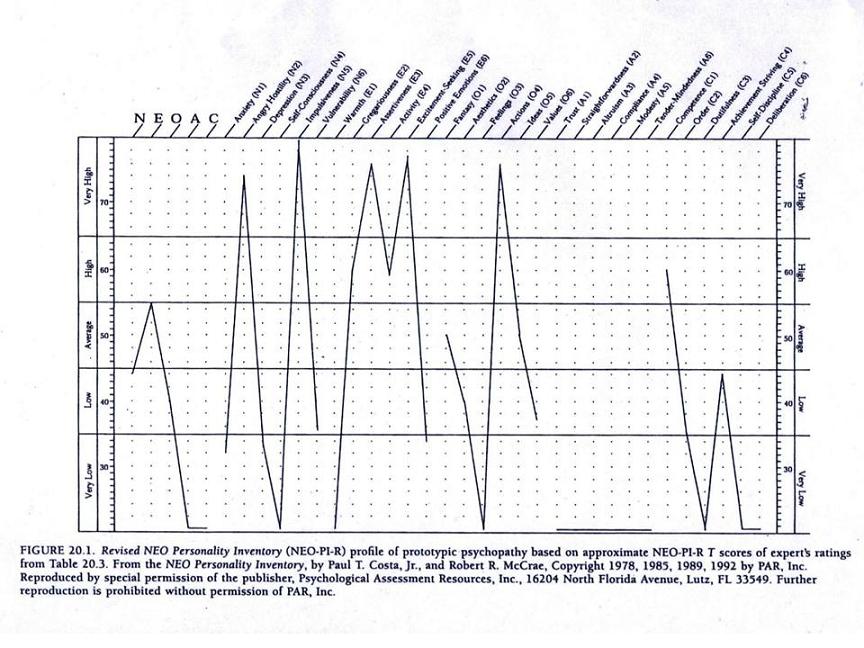DPPP: Psychopathy and the FFM

|
DPPP: Psychopathy and the FFM |
 |
It is homiletic to suggest that personality is related to psychopathy. Cleckley’s list of 16 diagnostic criteria for psychopathy is replete with personality traits. Nine of his diagnostic criteria are fairly standard personality descriptors: interpersonally charming, (absence of) nervousness, unreliability, insincerity, (lack of) shame, poor judgment, egocentricity, affectively impoverished, and interpersonally unresponsive. Five of the remaining seven characteristics reference “enduring patterns” of behavior and can therefore be considered to be assessing personality: inadequately motivated antisocial behavior, fantastic and uninviting behavior with drink and sometime without, suicide rarely carried out, an impersonal sex life, and failure to follow any life plan. The emphasis on personality is also found in Hare’s operationalization of psychopathy, the 20-item Hare Psychopathy Checklist-Revised (PCL-R; 1991). In the PCL-R, 13 of the 20 items assessed represent standard personality descriptors: glibness, grandiosity, need for stimulation, untruthfulness, manipulativeness, lack of guilt, shallow affect, callousness, poor behavioral control, lack of planning, impulsivity, irresponsibility, and failure to accept responsibility. At least four of the remaining 7 reference enduring behavior patterns: parasitic lifestyle, promiscuous sexual behavior, many short-term marital relations, and criminal versatility. We have attempted to argue something stronger. Psychopathy is a particular constellation of traits drawn from a general model of personality, namely the Five Factor Model of personality. We have also argued that understanding psychopathy in this way has several advantages. First, we believe such an understanding clarifies several issues in the psychopathy literature: 1) PCL-R factor structure, 2) patterns of comorbidity, 3) observed sex differences, 4) the litany of psychopathic deficits, and 5) the concept of successful psychopathy. Additionally, we believe that such an understanding has theory building implications. First, the traits can be used as bridges between psychopathy and basic research in personality. Second, the traits themselves may lead to additional theorizing regarding the link between psychopathy and deviance. We have examined psychopathy using the FFM in a variety of ways including translating the PCL-R items into the language of the FFM (i.e., PCL-R pathological lying – FFM low straightforwardness; Widiger & Lynam, 1998), generating expert ratings of the FFM traits considered most prototypical of psychopathic individuals (Miller, Lynam, Widiger, & Leukefeld, 2001) and examining correlations between the FFM and various psychopathy measures (Derefinko & Lynam, 2006; Gaughan, Miller, Pryor, & Lynam, in press; Hicklin & Widiger, 2005; Lynam, Derefinko, Caspi, Loeber, & Stouthamer-Loeber, 2007). As noted by Lynam & Widiger (2007), there is surprisingly strong consensus across these different methods about which traits are most relevant to psychopathy. For descriptive purposes we have rationally grouped these traits into five clusters: interpersonal antagonism (trust, straightforwardness, altruism, compliance, modesty, tendermindedness, warmth), pan-impulsivity (impulsiveness, excitement seeking, self-discipline, deliberation), interpersonal dominance (assertiveness), lack of self-directed negative affect (anxiety, depression, self-consciousness, vulnerability), and negative other directed affect (anger).
|
Original Prototype Approach
|
| Count Approach |
| Return to DPPP Homepage |